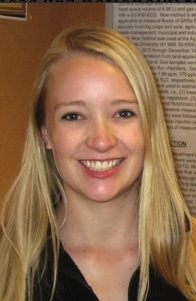
Features
Applications
Business/Policy
Environment
Environment Protection
Manure Management
Protection
Research
Sustainability
Swine
United States
ISU student places third for manure, GHG research
May 6, 2013 by Iowa State University
 Kelsey Bruning ISU
Kelsey Bruning ISUMay 6, 2013, Ames, IA – Kelsey Bruning, a senior in civil engineering who emphasizes environmental engineering at Iowa State University, showcased her research project in the Ron Sheffield Memorial Student Poster Contest in Denver, Col., and placed third with her submission.
The poster contest took place at the inaugural Waste to Worth: Spreading Science and Solution National Conference from April 1-5, 2013.
Dr. Jacek Koziel, an associate professor in the Department of Agricultural and Biosystems Engineering at Iowa State, offered Bruning a position in his research group after teaching her in a civil engineering course on air pollution. That class is co-taught by CCEE Professors Hans Van Leeuwen, Shauna Hallmark as well as Dr. Koziel. Her submission to the contest explained their research project entitled “Greenhouse Gas Emissions from Land-Applied Swine Manure: Development of Method Based on Static Flux Chambers.”
The researchers developed a method for measurement and estimation of greenhouse gases (GHGs) from land-applied swine manure. Bruning explained that with this research, they’re looking at the GHGs linked with climate change, especially GHGs emissions from agricultural practices. She explained applying manure to land is one of the most sustainable ways to recycle nutrients between plant and animal production systems. However, little is known about the extent of GHGs emissions from land application practices. Many crop farmers rely on the manure produced by hog operations for fertilizer, and there is a concern for the gas emissions being released from the manure that is then applied to post-harvest soil.
The group’s research method is based on gas emissions collected daily from four static flux chambers. It is applicable to measuring changes of greenhouse gasses from area sources involving crops and soils, agricultural waste management, municipal waste, and industrial waste. Their method was used at the AG 450 Farm from last October through November to assess GHG emissions from land-applied swine manure on cropland.
Estimates of the GHG changes they found will be used to develop GHG emission factors for estimation of emissions from swine manure in Midwestern corn-on-corn systems. Bruning explained that their research is contributing to the creation of a user-friendly model that would allow farmers to input information about their own operation in order to estimate the amount of air pollutants their farm emits and, if necessary, to develop strategies to lower that number. She said this would not only be beneficial for the environment, but it also would be cost-effective for the farmer.
Bruning said that, although this topic was entirely new to her when she joined the project, it is something she is very interested in because of her environmental engineering emphasis.
“I didn’t realize how big of an impact agriculture practices had on climate change,” she said.
She also said her coursework helped her prepare for the research project and the competition.
“The class [Dr. Koziel] taught definitely helped me prepare for this research project. I had a lot of environmental engineering classes that helped with my research – even classes I wasn’t expecting to directly use in my profession. I still use textbooks from past classes daily in my research.”
The research project will be completed around the end of this month as they finish their submissions to scientific journals.
For more on their research, visit www.extension.org/pages/67579/greenhouse-gas-emissions-from-land-applied-swine-manure:-development-of-method-based-on-static-flux-c.